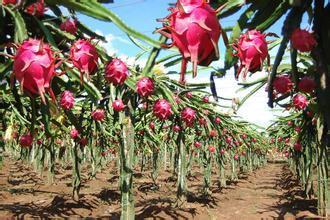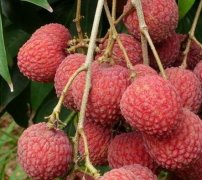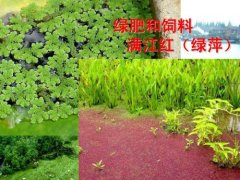Planting dragon fruit technology: what are the dragon fruit planting techniques and techniques?
If we want to grow dragon fruit, we first need to understand its characteristics and growing environment.
As the root system of Honglongguo is shallow and flat on the surface, the supplement of soil organic matter should fully apply organic matter fertilizer with low nitrogen and crude matter during the opening of the garden, so as to increase the soil organic matter content of 20 cm thick to more than 40.5%. In order to facilitate the full development and elongation of the root system in the future, and to buffer the adsorption and release of organic liquid fertilizer during irrigation. In addition, the number of fruit development days from flowering to harvest is only about 3335 days, and there are more than 8 batches of flowering every year, so the selected flowering period combined with the supply of high-nitrogen or low-nitrogen organic liquid fertilizer can stabilize the yield and improve the fruit quality.
The red dragon fruit is a perennial climbing succulent plant belonging to the triangular genus of Cactaceae. The varieties introduced in early Taiwan have self-incompatibility, low yield, small fruit and no market value, so there is little economic cultivation. In recent years, varieties with high fruit yield, high sweetness and self-compatibility have been selected, and their cultivation value has been greatly improved because they can be harvested within one year, coupled with the characteristics of resistance to diseases and insect pests and adverse environment.

The cultivated area of Taiwan is about 1000 hectares, and the yield per hectare is 23,27 metric tons. The central and southern part of Taiwan is an important producing area. However, the production period is too concentrated in summer, which has caused a lot of sales pressure. Although refrigerated storage has been used to partially adjust the shipment volume during the peak period, it is small because there are many fruits in summer, and
Low sweetness, coupled with the quality after cold storage is not ideal, so that consumers generally think that red dragon fruit is a cheap fruit of poor quality. It is not known that the autumn and winter fruit in November and December every year has a large temperature difference between day and night and less tree potential load during development, and there is no excessive adversity of Rain Water, its fruit is large and sweet, coupled with bright red color, so it is quite attractive to the market. However, as it is nearing the end of the production season, its output is very small, and the price is expensive; in the supermarket, ordinary consumers can only buy frozen fruits in summer, or imports transported over long distances, but have no chance to taste the high-quality connotation of the real red dragon fruit.
In recent years, due to the wholehearted commitment of some farmers to operation and management, red dragon fruit of high quality and high price can be produced even during the summer boom, prompting the red dragon fruit industry to gradually move into the ranks of high-value crops, coupled with the R & D benefits of winter fruit production adjustment technology. as a result, red dragon fruit has quickly become a popular new crop in China. Because the domestic red dragon fruit is not only charming in appearance, but also sweet and juicy, but also rich in vitamins, cellulose, glucose and minerals, coupled with the rare use of pesticides to control diseases and insect pests during the growth period, it can be called a healthy and delicious fruit.
In Taiwan's hot and humid island climate, among all kinds of economic crops, fruit trees are the least likely to adopt the farming system of organic cultivation, while Honglongguo is one of the few fruit trees that can be planted. Its characteristic is not only the advantages of strong plant growth and less harm to diseases and insect pests, but also that the red dragon fruit itself is a representation of healthy fruit and a high-yield cash crop; in addition, the management technology for the production of high-quality fruits in China has gradually matured, so it is the best time to consider adopting organic cultivation at this time.
Content 1. Supplement and maintenance of soil organic matter
Hong Longguo prefers a climate with year-round warmth, uniform rainfall distribution and sufficient sunshine. The soil must have good aeration and drainage, and the rich sandy loam is the best, and the soil pH value is between 5.5 and 7.5. For example, frost-prone areas and low-lying land with poor drainage in winter are not suitable for planting red dragon fruit, and good drainage is the first consideration of soil preparation in Honglong orchard. Therefore, the farmland converted from paddy field or high groundwater level should be cultivated in high border and break the impervious plough bottom to facilitate smooth drainage. Before preparing the soil, apply sufficient compost rich in crude fiber evenly, and its amount should be regarded as the soil organic matter in the 20 cm soil layer.
one
It depends on the content; when the general organic matter content is less than 2%, the dosage is 3040 metric tons / hectare; when it is between 23%, the dosage is changed to 2030 metric tons; if it is higher than 3%, the dosage is reduced to 1015 metric tons / hectare. The above dosage is to maintain the growth of the red dragon fruit root zone of the topsoil layer has a sufficient organic matter content of more than 40.5%. As the content of soil organic matter will decrease year by year due to microbial mineralization and decomposition, organic matter fertilizer with high nitrogen content is applied after pruning every winter to immediately supply the sprouting and vegetative growth of new shoots. At the same time, in order to protect the root activity of shallow roots, the border can be properly covered to inhibit the growth of weeds and the growth of conservation roots.
II. Protective measures against plant diseases and insect pests (1) Protection against anthracnose
During the vegetative growth period after pruning in winter, the mixture of lime and sulfur can be diluted 800-1200 or Kudong oil 300-500 times to prevent the spread of anthracnose. Once entering the reproductive growth period, the use of the above materials should be reduced or avoided as far as possible in order to maintain the appearance quality of the fruit. The susceptible branches cut off should be removed from the orchard immediately so as not to infect the healthy plants again.
(2) Protection of oriental fruit flies
Oriental fruit flies cause harm in the young fruit stage of Honglong fruit, so bagging should be carried out in advance to protect the fruit. At the same time, the shading protection of bagging can improve the bright red color of the pericarp and effectively improve the fruit quality. If you fail to bag early for some reason, you can spray citronella oil or peppermint oil 800-1000 times to avoid protection, but bagging should be done early to help the skin of the fruit intact and bright. In addition, hanging methyl clove oil trap around the orchard can also appropriately reduce the harm density of oriental fruit flies.
(3) pay attention to the occurrence of cactus virus X
At present, cactus virus X is the main source of virus infection in plants in red dragon fruit producing areas. its symptoms are green spots, mottles, gangrene and yellowing on the appearance of vine branches, which will affect the normal growth of plants and lead to the decline of fruit quality. For this viral disease
At present, there is no medicine for prevention and treatment, only healthy seedlings without virus disease and correct ones can be selected.
two
The use of agricultural tools (cutting ingots) to avoid the spread of machinery harm, so as to maintain the health and safety of red dragon fruit.
(4) Prevention of soot disease during bud period
The red meat variety of red dragon fruit is more prone to soot disease, and the dew of scales on the bud during high temperature will cause the occurrence of the disease; general plants can be sprayed (water) spray, or spray water cleaning for the bud one by one, which can reduce the degree of damage. For the seriously damaged fruit, the tip of the scale (calyx) will wither and break, which will affect the appearance of the fruit greatly.
Third, pay attention to the nutritional regulation of plants
April to October is the reproductive growth period of red dragon fruit bud formation, and there are different batches of bud formation according to different cultivation areas. In general, white meat species have about 6-9 batches of main mass-produced buds, while red meat species have about 10-12 batches. Since the interval between the appearance of each batch of buds is only about 15 days, and the number of days from bud to flowering is about 17 days, and the number of days of fruit growth is only 33 days, in order to avoid the phenomenon of poor fruit caused by excessive dispersion of nutrition supply during fruit development, it is necessary to carry out the following nutrition regulation:
(1) early bud thinning: the first bud thinning operation should be carried out when the bud length is about 2-3 cm, based on the principle of leaving 1 bud for each fruiting branch, and select buds of the same size, and delete the rest. Although it has been treated by bud selection mentioned above, the florescence may still stagger for up to 3-4 days at flowering time; therefore, it is still necessary to carry out the second flower bud thinning operation, at this time, the remaining flowering period is only 1 day staggered and the number of flowers is larger (usually the buds blooming on the second and third day). In this way, at the time of harvest, the difference in maturity (days) between fruits is only one day, which will avoid the phenomenon of uneven quality.
(2) keeping fruit in alternate batches: as the number of days between flowering stages of each batch is about 15 days, in order to avoid synchronous nutritional competition at the growth stages such as bract stage, flowering stage, green fruit stage and color conversion stage during the same fruit-bearing period, the decline of fruit quality or diversity of fruit products caused by the decline of fruit quality should be improved by the treatment of retaining flower buds at the interval of harvest, that is, to regulate and control the original production each month.
The second batch of fruit is now changed to produce only one batch. After this regulation and treatment, there will be
three
The protection of organic materials conducive to the control of diseases and insect pests, and the fertilizer management of fruit regulation and control.
Homework. Although this treatment will reduce the harvest of fruit quantity, it can increase.
The improvement of fruit rate and quality; therefore, the total annual output is only slightly reduced, but the total income can be increased.
Add. In addition, leaving fruit in different batches also has the effect of staggering the delivery period of batches, which is helpful to the market supply.
It is necessary to increase the price.
(3) full branches: if the triangular column branches become thin, flattened or withered during the reproductive period, it is a warning that the plant has been in the stage of malnutrition; this reason may be caused by too much fruit or insufficient organic topdressing, at the same time, we should also check whether the root system is damaged by flooding or improper application of organic materials.
Fourth, strengthen the fertilizer management of plants.
The fertilizer management of Honglongguo must pay special attention to the maintenance of soil moisture and the application of organic liquid fertilizer.
(1) Water management: the root system of Honglongguo is completely intolerant of flooding, so it will damage the root system in case of heavy rain and poor drainage. In general, soaking in water for 24 hours will damage most of the roots and cause the plant to wither gradually; therefore, good drainage is necessary for the opening of the garden. However, because its root system is shallow and widely distributed in the topsoil layer, the surface needs to be moist all the year round to ensure the vitality of the shallow root system; therefore, the border surface should be covered, while the gully surface (that is, the operation road) should adopt grass cultivation, which will fully take into account the water maintenance needs of the red dragon fruit. If spraying (spraying) water pipes can be installed under the orchard canopy, it can not only regulate the soil water supply, but also effectively and evenly regulate the spraying of organic liquid fertilizer.
(2) fertilization management: considering the physiological characteristics and morphology of red dragon fruit, it is suggested that foliar (branch) fertilizer should be used less, but soil fertilizer management should be strengthened. The soil fertilization skills are as follows:
1. Base fertilizer: organic matter fertilizer with high nitrogen, phosphorus, potassium and high organic quality was mainly applied to the whole garden after harvest and pruning from late November to December. After the application of base fertilizer, the border surface under the crown can be covered with rice straw in the second stage, while the furrow surface (operation road) can be ploughed at a depth of 10 cm to 15 cm to ensure the physical and chemical function of the base fertilizer applied.
four
two。 Topdressing: the irrigation of soil organic liquid fertilizer is the main topdressing method, and the points for attention are as follows: (1) during the vegetative growth period of shoot growth, organic liquid fertilizer with balanced proportion of nitrogen, phosphorus and potassium fertilizer is selected. (2) the period from flower appreciation to green fruit before color change: choose organic liquid fertilizer with high nitrogen and low potassium, such as mushroom liquid fertilizer and fish essence fertilizer, etc. (3) the period of color conversion to harvest: choose organic liquid fertilizer with low nitrogen and high potassium (phosphorus), such as soybean liquid fertilizer plus plant ash, or seaweed liquid fertilizer, etc. Watering with soil organic liquid fertilizer during the fruit-carrying period can provide sufficient soil moisture at the same time to facilitate the hypertrophy and development of the fruit. As for the frequency of topdressing should be determined by the change of branch morphology, generally, if a branch gradually shows a dry flat shape during the fruit-bearing period, which means that the amount of topdressing is insufficient, the amount of topdressing or the frequency of topdressing should be strengthened to maintain strong tree potential.
5. Regular analysis of soil fertility
Every year, during the period from harvest to pruning, the topsoil (about 15 cm thick) between planting rows should be taken for soil fertility analysis. Its purpose is to: (1) pay attention to the changes of EC value (soil electrical conductivity), PH value (soil acid-base reaction) and OM value (soil organic matter), so as to ensure the safe regulation of organic materials applied without affecting the normal growth of plants. (2) self-examine the residual contents of phosphorus, potassium, calcium and magnesium to confirm whether the quality and quantity of organic materials applied in the past year are appropriate, and whether there are excessive cumulative residues or decreasing deficiencies year by year.
- Prev

How to manage jade purse litchi? What should I do after picking lychee with jade purse?
Management operation of Yughubao litchi after harvest how to maintain it after harvest? How can we establish a good tree shape and how to apply fertilizer? Let's take a look at it together. 1. Do a good job in pruning, cultivate strong fruit branches, and build
- Next

Why does Manjianghong serve as green manure? Is Manjianghong an excellent green manure and feed?
Application of Manjiang Red and Green Fertilizer in Paddy Field farming: Manjianghong we have always been regarded as aquatic pollution plants, but in fact, it is good, if you do not know, then take a look at this. It is of great use in paddy fields. Reduce food crops
Related
- Fuxing push coffee new agricultural production and marketing class: lack of small-scale processing plants
- Jujube rice field leisure farm deep ploughing Yilan for five years to create a space for organic food and play
- Nongyu Farm-A trial of organic papaya for brave women with advanced technology
- Four points for attention in the prevention and control of diseases and insect pests of edible fungi
- How to add nutrient solution to Edible Fungi
- Is there any good way to control edible fungus mites?
- Open Inoculation Technology of Edible Fungi
- Is there any clever way to use fertilizer for edible fungus in winter?
- What agents are used to kill the pathogens of edible fungi in the mushroom shed?
- Rapid drying of Edible Fungi

